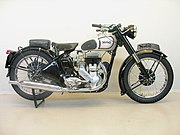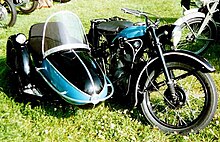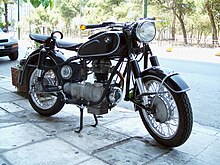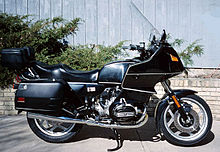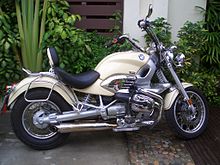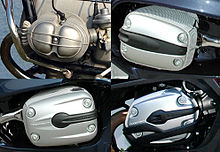Wartime WW2 production of the military Model 16h and Big4 sidevalve motorcycles was Nortons contribution to the war effort, almost 100,000 being manufactured.
When major shareholders started to leave Norton in 1953, the company declined and Associated Motor Cycles bought the shares.[2] Although motorcycle sales went through a recession in the 1950s, and Norton Motors Ltd was only a small manufacturer, Norton sales flourished. A series of Norton Dominator Twins of 500cc, then 600cc, then 650cc and then the 750cc Norton Atlas kept sales bouyant, especially with sales to the USA.
In 1968, the new 750cc Norton Commando Model appeared, with the engine/gearbox/swingarm unit "isolastically" insulated from the frame with a series of rubber mountings. This kept the vibrations from the rider, giving a smooth comfortable ride. The Commando was a best seller, and voted #1 Motorcycle of the Year a number of times in Britain. 850cc Models appeared for 1973, giving more torque. And for 1975 an electric start arrived in the 850 Mk3.
Political manoeuvrings brought the downfall of Norton and other manufacturers in the 1970s - taxpayer assisted wranglings over amalgamations and sell-offs all but killing the industry.
In late 2008, Stuart Garner, a UK businessman, bought the rights to Norton from some US concerns and relaunched Norton in its Midlands home at Donington Park where it will develop the NRV588 racer, a machine styled after the Norton Commando,[3] and a new range of Norton motorcycles, with options including 1200 cc Superbike, and 750 cc Supersport variants.[4]
The original company was formed by James Lansdowne Norton (known as "Pa") at 320, Bradford Street, Birmingham in 1898.[1] In 1902, Norton began building motorcycles with French and Swiss engines. In 1907, a Norton ridden by Rem Fowler won the twin-cylinder class in the first Isle of Man TT race, beginning a sporting tradition that went on until the 1960s. The Isle of Man Senior TT, the most prestigious of events, was won by Nortons ten times between the wars and then every year from 1947 to 1954. The first Norton engines were made in 1908, beginning a line of side-valve single cylinder engines which continued with few changes until the late 1950s.[2]
The first Norton logo was a fairly simple, art nouveau design, with the name spelled in capitals.[5] However, a new logo appeared on the front of the catalogue for 1914, which was a joint effort by James Lansdowne Norton and his daughter Ethel. It became known as the "curly N" logo, with only the initial letter as a capital, and was used by the company thereafter, first appearing on actual motorcycles in 1915.[6] Ethel Norton also did some testing of her father's motorcycles.[citation needed] In 1913 the business declined. R.T. Shelley & Co., the main creditors, intervened and saved it. Norton Motors Ltd was formed shortly afterwards under joint directorship of James Norton and Bob Shelley. J.L. Norton died in 1925 aged only 56, but he saw his motorcycles win the Senior and sidecar TTs in 1924.[7]
Designed by Walter Moore, the Norton CS1 engine appeared in 1927, based closely on the ES2 pushrod engine and using many of its parts. On his departure to NSU in 1930, an entirely new OHC engine was designed by Arthur Carroll, which was the basis for all later OHC and DOHC Norton singles. (Moore's move to NSU prompted staff to claim that NSU stood for "Norton Spares Used") That decade spawned the Norton racing legend. Of the nine Isle of Man Senior TTs (500 cc) between 1931 and 1939 Norton won seven.[8]
Until 1934, Norton bought Sturmey-Archer gearboxes and clutches. When Sturmey discontinued production Norton bought the design rights and had them made by Burman, a manufacturer of proprietary gearboxes.
Nortons also appealed to ordinary motorcyclists who enjoyed the reliability and performance offered by single-cylinder engines with separate gearboxes. The marque withdrew their teams from racing in 1938, but between 1937 and 1945 nearly a quarter (over 100,000) of all British military motorcycles were Nortons, basically the WD 16H (solo) and WD Big Four outfit with driven sidecar wheel.[2]
Post war
After the Second World War, Norton reverted to civilian motorcycle production, gradually increasing its range. A major addition in 1949 was the Model 7, later known as the Norton Dominator, a pushrod 500 cc twin-cylinder machine designed by Bert Hopwood. Its chassis was derived from the ES2 single, with telescopic front and plunger rear suspension, and an updated version of the gearbox known as the "lay-down" box.Post war, Norton struggled to reclaim its pre-WWII racing dominance as the single cylinder machine faced fierce competition from the multi-cylinder Italian machines and AJS from the UK. In the 1949 Grand Prix motorcycle racing season, the first year of the world championship, Norton made only fifth place and AJS won. That was before the Featherbed frame appeared, developed for Norton by the McCandless brothers of Belfast in January, 1950, used in the legendary Manx Norton and raced by riders including Geoff Duke, John Surtees and Derek Minter. Very quickly the featherbed frame, a design that allowed the construction of a motorcycle with good mass-stiffness distribution,[9] became a benchmark by which all other frames were judged.[8]
Norton also experimented with engine placement, and discovered that moving the engine slightly up/down, forward/back, or even right/left, could deliver a "sweet spot" in terms of handling. Motorcycle designers still use this method to fine-tune motorcycle handling.[10]
In 1951, the Norton Dominator was made available to export markets as the Model 88 with the Featherbed frame. Later, as production of this frame increased, it became a regular production model, and was made in variants for other models, including the OHV single-cylinder machines.
Manx Nortons also played a significant role in the development of post war car racing. At the end of 1950, the English national 500 cc regulations were adopted as the new Formula 3. The JAP Speedway engine had dominated the category initially but the Manx was capable of producing significantly more power and became the engine of choice. Many complete motorcycles were bought in order to strip the engine for 500 cc car racing, as Norton would not sell separate engines.
The racing successes were transferred to the street through cafe racers, some of whom would use the featherbed frame with an engine from another manufacturer to make a hybrid machine with the best of both worlds. The most famous of these were Tritons - Triumph twin engines in a Norton featherbed frame.
 Pre-unit Triumph engined Triton Café racer |
AMC
Main article: Associated Motorcycles
Despite, or perhaps because of the racing successes, Norton was in financial difficulty. Reynolds could not make many of the highly desired featherbed frames and customers lost interest in buying machines with the older frames. In 1953 Norton sold out to Associated Motorcycles (AMC), who owned the brands AJS, Matchless, Francis-Barnett and James. The Norton factory in Bracebridge Street, Birmingham was closed in 1962 and production was moved to AMC's Woolwich factory in southeast London.Under AMC ownership a much improved version of the Norton gearbox was developed, to be used on all the larger models within the corporation under the AJS, Matchless and Norton brands. Again, the major changes were for improved gear selection.
Late in 1955, a 600 cc Dominator 99 was launched. The 1946 to 1953 Long Stroke Manx Norton was 79.6 × 100 mm (3.1 × 3.9 in) initially SOHC, the DOHC engine becoming available to favoured racers in 1949. The Short Stroke model (1953 to 1962) had bore and stroke of 86 × 85.6 mm (3.4 × 3.4 in). It used a dry sump 499 cc single-cylinder motor, with two valves operated by bevel drive, shaft driven twin overhead camshafts. Compression ratio was 11:1. It had an Amal GP carburettor, and a Lucas racing magneto. The 1962 500 cc Manx Nortons produced 47 bhp (35 kW) at 6,500 rpm, weighed 142 kg (313 lb), and had a top speed of 209 km/h (130 mph).[11] The new price was £440 (2009: £8,000).
In 1960, a new version of the roadgoing featherbed frame was developed with the upper frame rails bent inwards to reduce the width between the rider's knees for greater comfort. The move was also to accommodate the shorter rider as the wide frame made it difficult to reach the ground. This frame is known as the "slimline" frame; the earlier frames then became known as the "wideline".
The last Manx Nortons were sold in 1963. Even though Norton had pulled out of racing in 1954, the Manx had become the backbone of privateer racing, and even today are quite sought after.
On November 7, 1960 the first new 650cc Norton Manxman was launched for the American market only. By October 1961 The Norton 650SS appeared for the UK market ,The 750cc Norton Atlas. in April 1962 for the American market as they demanded more power. Featherbed frames were still used, but the increases to the vertical twin engine's capacity caused a vibration problem at 5500rpm. A 500cc vertical twin is smoother than a single cylinder, but if the vertical twin's capacity is enlarged vibration increases. The 750 Norton Atlas proved too expensive and costs could not be reduced. Financial problems gathered.[12]
There was an export bike primarily for use as a desert racer, sold up until 1969 as the Norton P11,[13] AJS Model 33 and as a Matchless G15, which used the Norton Atlas engine in a modified Matchless G85CS scrambler frame with Norton wheels and front forks. This bike was reputed to vibrate less than the featherbed frame model. AMC singles were also sold with Norton badging in this era.[14]
Also during this period Norton developed a family of three similar smaller-capacity twin cylinder machines: first the Norton Jubilee 250 and then the Navigator 350 and Electra 400, which had an electric starter. These models were Norton's first use of unit construction. The engine was an entirely new design by Bert Hopwood and the frame and running gear were from the Francis-Barnett range, also owned by AMC. These machines had a reputation for poor reliability.[citation needed]
Norton-Villiers
Main article: Norton-Villiers
By the late 1960s, competition from Japanese manufacturers and a rapidly-declining home market[citation needed] had driven the whole British motorcycle industry into decline. In 1966 AMC became insolvent and was reformed as Norton-Villiers, part of Manganese Bronze Holdings Ltd.The 750 Norton Atlas was noted for its vibration. Rather than change engines Norton decided to change the frame, and the isolastic-framed Norton Commando 750 was the result.
In 1969, the Commando was introduced. Its styling, innovative isolastic frame and powerful engine made it an appealing package. The Commando easily outperformed contemporary Triumph and BSA twins and was the most powerful and best-handling British motorcycle of its day. The isolastic frame made it much smoother than the Atlas. It used rubber bushes to isolate the engine and swinging arm from the frame, forks, and rider. However, as the steel-shims incorporated in the Isolastic bearings wore, often from rusting, the bike became prone to fishtailing in high-speed turns.[clarification needed]
The "Combat" engine was released in January 1972, with a twin roller bearing crank, 10:1 compression and developing 65 bhp (48 kW) at 6,500 rpm. Reliability immediately suffered, with frequent and early crank-shaft main-bearing failures, sometimes leading to broken crankshafts. Older engines had used one ball-bearing main bearing and one roller bearing main bearing but the Combat engine featured two roller bearings in a mistaken belief this would strengthen the bottom-end to cope with the higher power-output. Instead the resultant crank-bending caused the rollers to "dig-in" to the races, causing rapid failure. This fragility did not show up well,[clarification needed] especially when compared with the reliability of contemporary Japanese machines.[15]
The Commando was offered in several different styles: the standard street model, a pseudo-scrambler with upswept pipes and the Interstate, packaged as a tourer. Electric start was introduced on the Mark III in 1974. Sales were respectable but the company declined financially and became insolvent in 1975.[8] In 1976 a Norton with a US-flag theme on the tank could be purchased for US$1,976.
Norton Villiers Triumph
Main article: Norton Villiers Triumph
In 1972, BSA was also in financial trouble. It was given UK Government help on the condition that it merged with Norton-Villiers, and in 1973, the new Norton Villiers Triumph (NVT) was formed. The Triumph Motorcycles name came from BSA's Triumph subsidiary. In April 1973 an 8.5:1 compression 828 cc "850" engine was released with German FAG SuperBlend bearings. These, featuring slightly barrel-shaped rollers, had been introduced on late model 750 cc engines to cure the Combat engine's problems of crank-flex and the consequent digging-in to the bearing-surface of the initial cylindrical bearing rollers. This model produced 51 bhp (38 kW) at 6,250 rpm but the stated power does not give a true picture of the engine performance because increased torque seemed to make up for the reduced horsepower.[16]In 1974, the UK's outgoing Conservative government withdrew subsidies, but the incoming Labour government restored them after the General Election. Rationalisation of the factory sites to Wolverhampton and Birmingham (BSA's Small Heath site) caused industrial disputes at Triumph's Coventry site; Triumph would go on as a workers cooperative alone. Despite mounting losses, 1974 saw the release of the 828 Roadster, Mark 2 Hi Rider, JPN Replica (John Player Norton) and Mark 2a Interstate. In 1975, the range was down to just two models: the Mark 3 Interstate and the Roadster, but then the UK Government asked for a repayment of its loan and refused export credits, further damaging the company's ability to sell abroad. Production of the two models still made was ended and supplies dwindled.
Wankel engine
In the 1980s, the company went through several incarnations – mainly because the name was popular and now owned by several parties. In liquidation from NVT the global rights were split between (at least) Norton UK, Germany, America and Rest of the World.The brand was relaunched on an ambitious scale in Lichfield in 1988. The new models succeeded in racing – winning the Senior TT in 1992 – but they moved rather more slowly in the commercial market. The company had some success making the Wankel-engined Interpol 2 motorcycle for civilian and military police forces and the RAC. This led to a civilian model in 1987 called the Classic.
Subsequent Norton Wankels were water-cooled. The Commander was launched in 1988 and was followed by the Spondon-framed F1. This model was a de-tuned replica of Norton's RCW588 factory racing machines which won many races including the 1992 Isle of Man TT, ridden by Steve Hislop. The F1 was succeeded by the restyled and slightly less expensive F1 Sport. Chief Executive Phillippe LeRoux attempted to diversify the company to a group with interests in property and leisure,[17] meanwhile supply of Norton Classic was being delayed by supply problems with petrol tanks and headlight shells.[citation needed]
At this point the UK Department of Trade and Industry started to investigate improprieties in the investments of financier Philippe LeRoux and his associates[18] following which LeRoux resigned his position as Chief Executive.[19]
In a move to manage an outstanding debt of ₤7million, in 1991, David MacDonald was appointed Chief Executive at the behest of the Midland Bank. McDonald sold the company to the North American company Wildrose Investments. Head of Wildrose investments, Nelson Skalbania, reformed the company as Norton Motors (1993) Ltd, putting his daughter Rosanda in place as General Manager at the Shenstone site.[20] The new ownership attempted to reclaim Triumph and Norton motorcycles that had been loaned to various science and technology museums. This proved controversial as some of the museums had assumed the loans had been made on a permanent basis.[21] In 1994 ownership of the company reverted to Aquilini Investments as Skalbania was unable to repay the money he had borrowed to purchase the company. The Skalbania connection was reported as being severed by July of that year [22] By 1996 the service side of the Shenstone site was closed and transferred to Startright Motors[23] in Leeds, and Reg Allen Motorcycles in Acton, London. The focus of manufacture was moved to the manufacture of components for light aircraft engines based on the rotary design.
It was reported in 2005 that a group of former Norton employees built nine F1 sports models from existing stocks of parts.[24]
A number of firms continued spares and service support for various generations of piston-engined Nortons, including Andover Norton,[25] Mick Hemmings,[26] Norvil (formerly Fair Spares), RGM Motors,[27] Unity Equipe and Norman White (a former team racer and mechanic).[28]
 Ron Haslam on a rotary-engined Norton RCW588 racer |
Replicas and revival
During the late 1990s, Kenny Dreer of Oregon evolved from restoring and upgrading Commandos to producing whole machines. He modernised the design and in the early 2000s went into series production with the 961 Commando, but then suspended operations in April 2006.After fifteen years of US ownership the Norton brand has now been secured by Stuart Garner, UK businessman and owner of Norton Racing Ltd. Garner is developing a new 15,000 sq ft (1,400 m2) Norton factory at Donington Park.[29] The Dreer machines is an 88 × 79 mm (3.5 × 3.1 in), giving an actual cylinder capacity of 961 cc, air and oil-cooled pushrod parallel twin with a 270° crank and a gear-driven counterbalancer. The machine is a single seater styled after the earlier Commando models. A power output of 80 bhp (60 kW) at the rear wheel is claimed, giving a top speed of in excess of 130 mph (210 km/h).[4][30]
The new operation at Donington Park has gone into limited production producing a motorcycle based on the Kenny Dreer 961 Commando. The new motorcycle only shares the outline of the Dreer bike, all aspects of the motorcycle have apparently been re-designed in order to move into production. An updated and revised version of the rotary by Brian Crighton, an engineer who worked on the rotary machine in the 1990s is also being developed. To expand the range of machines available, the company has acquired a significant interest in Maxsym Engine Technology with the aim of using the Maxsym parallel twin engine, originally developed for Moto GP as the basis of a new range of Norton motorcycles, with options including 1,200 cc Superbike, and 750 cc Supersport variants.[4]
http://en.wikipedia.org/wiki/Norton_Motorcycle_Company




